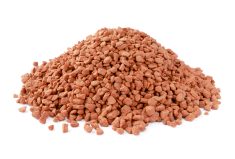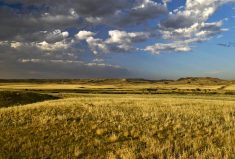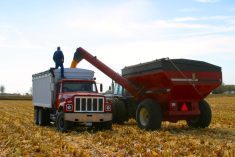While many Canadian farmers say policies to reduce carbon emissions will make them uncompetitive, Aussie producers are setting ambitious climate mitigation goals to meet international customers’ growing demand for sustainable food.

“The (Australian) agriculture industry has really led this and has been pushing for these sorts of policy changes… ” Richard Heath, executive director of the Australian Farm Institute, told the Trade and Climate Change Virtual Conference April 7, organized by the Canadian Agricultural Policy Institute and Washington, D.C.-based Farm Foundation.
When it comes to pushing for climate change mitigation there’s a big gap between Australian farmers and their government “which has been resistant to significant change and embracing some of these more ambitious climate targets,” Heath told the online conference.
Why it matters: Meeting sustainability standards could be a prerequisite to supplying premium markets.
Heath said the European Union’s Farm to Fork Strategy lays out a plan to make its farmers more sustainable and to cut their carbon emissions by 2030.
Read Also

Mazergroup’s Bob Mazer dies
Mazergroup’s Bob Mazer, who helped grow his family’s company into a string of farm equipment dealerships and the main dealer for New Holland machinery in Saskatchewan and Manitoba, died July 6 from cancer.
It includes reducing pesticide and antibiotic use by 50 per cent, fertilizer by 20 per cent and increasing the area under organic agriculture to 25 per cent, compared to eight per cent now.
Heath expects those who want to export food to the EU will have to meet its sustainability standards and that other food-importing countries will adopt similar standards.
Like Canada, Australia agriculture is “heavily trade dependent.”
“Around 70 per cent of the value of agricultural production in Australia is exported each year,” Heath said.
The percentage is even higher for wheat, canola, red meat and sugar, he added.
When asked why Australian farmers aren’t worried about climate policies making them uncompetitive, Heath replied: “I’ve yet to see a methodology that mitigates greenhouse gas emissions for agriculture that doesn’t have productivity benefits. Losing carbon from a production system is waste. If you’re losing it from the soil, if you’re losing methane from cattle that’s waste out of the system. If you can introduce different methods which retain carbon you increase your efficiency.
“If you retain carbon in soils and cropping systems you are increasing the water-holding capacity, you’re increasing soil health, you’re increasing nutrient cycling, all things that have productivity benefits. Greenhouse gas mitigation doesn’t have a negative productivity impact on agricultural production. There is a cost and it’s about balancing the cost so that productivity benefit is more than the practice change.”
Australian farmers are already suffering because of climate change, he added. One study shows if Australian farmers were still growing wheats from 1990, between then and 2015 average yields would have declined 27 per cent. They didn’t because of improved genetics.
Canadian farmers say Canada’s carbon tax adds to farmers’ costs by increasing the price of drying grain and heating barns.
Aaron Cosbey of Small World Sustainability Consulting told the meeting the carbon tax raises farmers’ cost indirectly by making fertilizer and transporting farm products to market more expensive.

There is “low-hanging fruit,” when it comes to farmers reducing emissions, but farmers face higher costs when more “ambitious” emission goals are set, he said.
“Those are going to be the crunchy issues,” Cosbey said.
“There are trade implications of going further into the really tough competitiveness issues.”
Border Carbon Adjustments (BCA) are touted as a tool to keep domestic industries subject to domestic emission reduction policies competitive with foreign competitors not facing those constraints. But Cosbey said he doubts they’ll be used in agriculture.
Alternatives include developing new technologies to help farmers cut emissions, he said.
Subsidies are another option to help farmers transition to practices that use fertilizer more efficiently or reduce tillage.
Exposing farmers to the cost of carbon will also drive efficiency, David Blandford, professor emeritus, agricultural and environmental economics at Penn State University, told the conference.
Researchers in the United Kingdom have discovered some practices to reduce carbon emissions from agriculture make farmers more profitable, he said.
“Farmers are fairly conservative folks for good reason and sometimes it may not occur to them that this alternative approach to ‘my production’ could actually lower emissions, so the education thing that I indicated is important,” he said.
Instead of subsidizing farmers in the United States to set aside fragile land for hay and cattle, the program could be modified to encourage tree production, Blandford said.
There’s no conflict between reducing carbon emissions and increasing agricultural productivity and food security, he said.

“This may well mean that within individual countries there’s going to have to be a shift in resources from the production of some products towards the production of others,” Blandford said. “And that can create adjustment challenges, but there is no overall conflict here between having technologies that increase productivity and lower emission per unit of output with food security.”
By 2030 or so agriculture might be one of the world’s biggest carbon emitters if emissions are dramatically cut from transportation, he said.
“I think the first thing for farmers to realize is they’ve got to be on board with anything they can do to reduce emissions intensity in agriculture,” Blandford said. “They don’t want to be opposing it. They should be supporting it.”
Getting more carbon into soil has multiple environmental benefits, including boosting crop yields.
“Farmers need to be able to push the agenda to more environmentally friendly technologies, the generation of those technologies and the adoption of those technologies. This is the key: don’t fight this stuff. Line up behind it and use it to your advantage. I think that would be my No. 1 message.”
Australian farmers are already working towards that.
“We have traded for some time just on our reputation of being clean and green,” Heath said. “Reputation will no longer be good enough. It will need to be evidenced based.
“If we want to continue to access premium markets and have the ability to set the price a little bit rather than the lowest-cost producer taking the lowest price we will have to find ways of mitigating greenhouse emissions in a way that produces productivity benefits for an economic advantage. And I think that’s possible, I really do. That’s the pathway that we are taking.”
The current Australian government isn’t on side, but it doesn’t matter, he said.
“The ability to access markets and supply chains is what’s going to drive change,” Heath said. “And that’s already happening. That is the requirement of so many supply chains now. In many aspects government policy is irrelevant in this going forward.”




















